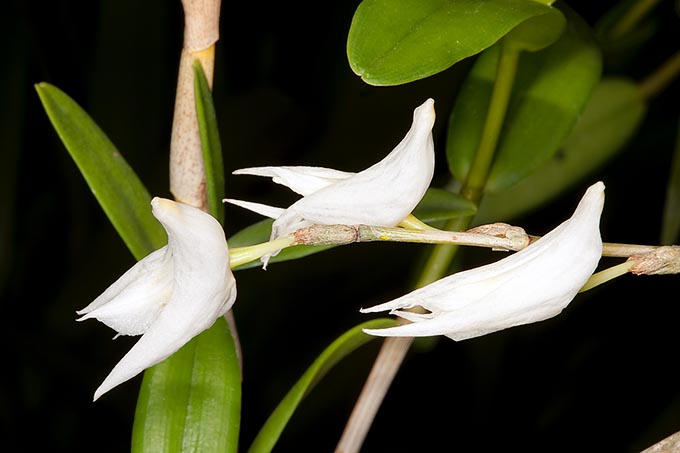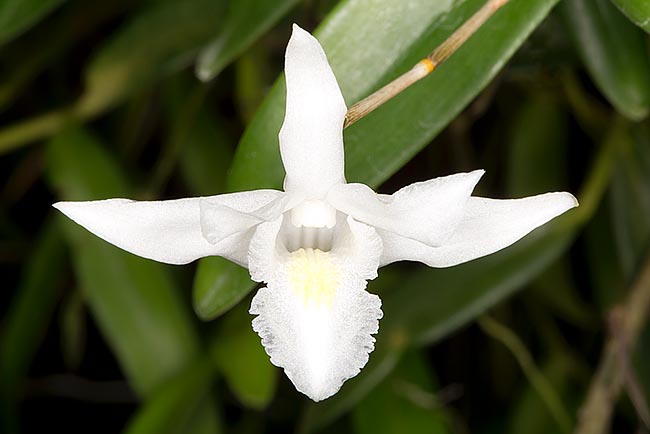Family : Orchidaceae

Text © Pietro Puccio

English translation by Mario Beltramini

White doves on a branch ready to fly? No, three flowers of Dendrobium crumenatum © Giuseppe Mazza
The name of the genus is the combination of the Greek terms “déndron” = tree and “bios” = life, with reference to the numerous species of the genus living on the trees; the name of the species comes from the Latin “crumena” = bag, therefore, bag-shaped, with reference, after some, to the saccate spur (mentum).
Common names: dove orchid, pigeon orchid, sparrow orchid (English); mu shi hu (Chinese); orchidea colomba, orchidea dei temporali (Italian); anggrek merpati, bunga angin, poko merpati (Malaysian); buap klaang haao, ueang mali, waai tamoi (Thai).
The Dendrobium crumenatum Sw. (1799) is an epiphytic species with cylindrical, up to about 1 m long, stems, presenting over the base, for a length of 8-12 cm, a fusiform enlargement, of 2-3 cm of diameter, leafless, grooved, of greenish yellow colour, which serves as a reserve of water during the dry periods. The median part, thin, is provided with leaves, whilst the terminal one does not have them; the leaves are ovate-oblong, coriaceous, alternate and distichous, 6-9 cm long and 1,5-3 cm broad, with bilobed apex. In the leafless single nodes of the terminal part, are present several dormant floral buds which develop, usually one at a time, after a sudden decrease of temperature of 6-10 °C, thing which, at the tropics, may happen during a violent rain. After 8-10 days, the flowers open at the same time on several nodes of the ripe stems, and are intensely and pleasantly scented and last one day only; the flowering may reiterate several times during the year.
The flowers, of 4-5 cm of diameter, have pure white sepals and petals or, at times, with a pink shade at the apices; the labellum is white with at the base some indented parallel lamellae of yellow colour. The dorsal sepal is ovate-lanceolate, 2-2,5 cm long and 0,5 cm broad, the lateral ones are lanceolate-triangular, 2,5-3,5 cm long and about 0,7 cm broad, united at the base of the column thus forming a sort of a spur (mentum), 1,5 cm long.

The open flower can reach 5 cm. Leaves and speudobulbs have medicinal virtues © Giuseppe Mazza
It reproduces by seed, in vitro, micropropagation, division and through the young plants which often form at the nodes (colloquially, the “keiki”, which, in Hawaiian, means “sons”), that can be removed once they have formed a good rooting apparatus.
Species with a particular mode of flowering, much diffused in its origin areas, which easily reproduces and tillers also in cultivation, it requires medium-high temperatures with low ones over the 14 °C, even if it bear, for quite a very short period, provided perfectly dry, some degrees less, high humidity, 60-80%, luminosity and a constant, good, ventilation. Watering must be regular, even if it may stand dry periods, especially in winter.
For the waterings and the nebulisations, rain water is to be utilized, or water obtained by reverse osmosis, or demineralised; the fertilizations, duly distributed in order to avoid salts accumulations, are to be done during the vegetative period preferably with hydrosoluble balanced products, with microelements, at ¼ of the dosage suggested on the package. It can be mounted on bark, trunks, cork or arborescent ferns roots rafts, or cultivated in pot with much draining and aerated compost, which may be formed by medium sliced bark fragments with addition of moss.
Parts of the plant, in particular the leaves and the juice extracted from the pseudobulbs, are utilized in the traditional medicine.
The species is reported in the appendix II of the CITES (species whose trade is internationally ruled).
Synonyms: Epidendrum caninum Burm.f. (1768); Epidendrum saaronicum J.König (1791); Epidendrum ceraia Raeusch. (1797); Onychium crumenatum (Sw.) Blume (1825); Dendrobium ceraia Lindl. (1830); Callista crumenata (Sw.) Kuntze (1891); Dendrobium schmidtianum Kraenzl. (1901); Dendrobium papilioniferum J.J.Sm. (1905); Dendrobium simplicissimum (Lour.) Kraenzl. (1910); Dendrobium kwashotense Hayata (1914); Dendrobium ephemerum (J.J.Sm.) J.J.Sm. (1917); Dendrobium caninum (Burm.f.) Merr. (1921); Aporum crumenatum (Sw.) Brieger (1981); Aporum ephemerum (J.J.Sm.) Rauschert (1983); Aporum kwashotense (Hayata) Rauschert (1983); Aporum papilioniferum (J.J.Sm.) Rauschert (1983); Ceraia saaronica (J.König) M.A.Clem. & D.L.Jones (2002); Ceraia ephemera (J.J.Sm.) M.A.Clem (2003); Ceraia papilionifera (J.J.Sm.) M.A.Clem. (2003); Ceraia parviflora (Ames & C.Schweinf.) M.A.Clem. (2003).
→ For general notions about ORCHIDACEAE please click here.
